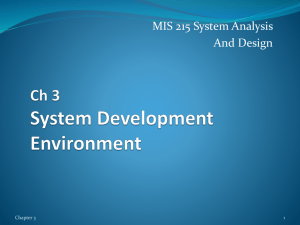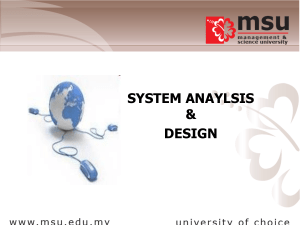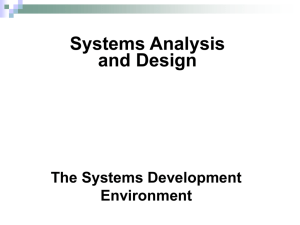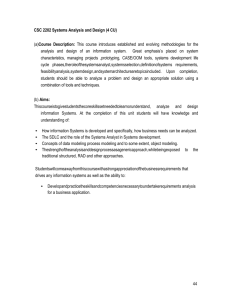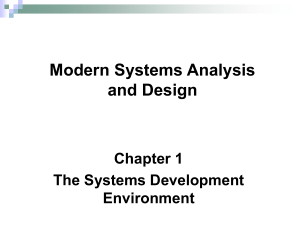System Development Methodologies
advertisement
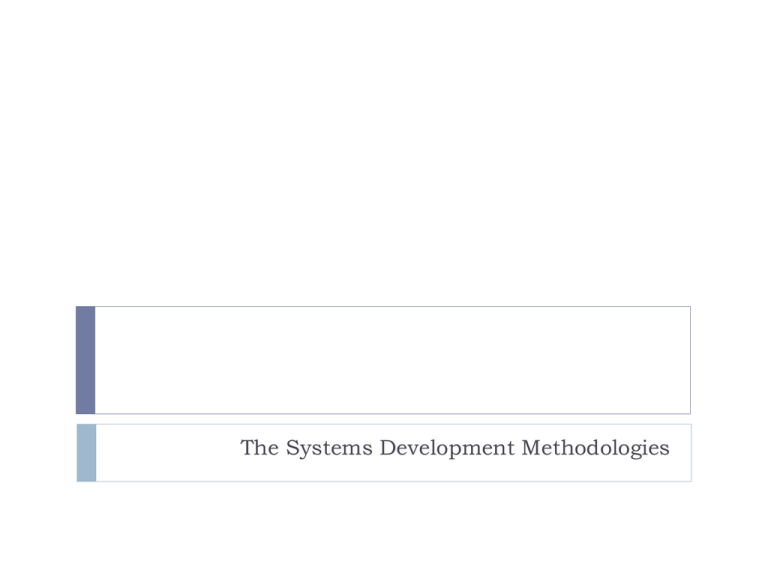
The Systems Development Methodologies Objectives Describe the information Systems Development Life Cycle (SDLC) Explain prototyping Explain Rapid Application Development (RAD) Describe Join Applications Development (JAD) *** A Bit of History… 1950s: focus on efficient automation of existing processes 1960s: advent of 3GL, faster and more reliable computers 1970s: system development becomes more like an engineering discipline 1980s: major breakthrough with 4GL, CASE tools, object oriented methods 1990s: focus on system integration, GUI applications, client/server platforms, Internet The new century: Web application development, wireless PDAs, component-based applications Methodology System Development Methodology is a standard process followed in an organisation to conduct all the steps necessary to analyse, design, implement, and maintain information systems (Hoffer, 200?) Systems Development Life Cycle Planning Problem definition Feasibility study Analysis Design Implementation Maintenance SDLC Planning Analysis system requirements are studied and structured Design an organisation’s total information system needs are identified, analysed, prioritised, and arranged a description of the recommended solution is converted into logical and then physical system specifications Logical design all functional features of the system chosen for development in analysis are described independently of any computer platform SDLC Physical design Implementation the logical specifications of the system from logical design are transformed into the technology-specific details from which all programming and system construction can be accomplished the information system is coded, tested, installed and supported in the organisation Maintenance an information system is systematically repaired and improved SDLC – Traditional Waterfall Problems with the Waterfall SDLC System requirements “locked in” after being determined (can't change). Limited user involvement (only in requirements phase). Too much focus on milestone deadlines of SDLC phases to the detriment of sound development practices *** Alternatives to SDLC Computer Aided Software Engineering (CASE) tools Prototyping Joint Application Development Rapid Application Development Agile methodologies eXtreme programming Object Oriented Programming (OOP) *** Prototyping CASE Tools Diagramming tools enable graphical representation Computer displays and report generators help prototype how systems “look and feel” Analysis tools automatically check for consistency in diagrams, forms, and reports Central repository for integrated storage of diagrams, reports, and project management specifications Documentation generators standardise technical and user documentation Code generators enable automatic generation of programs and database code directly from design documents, diagrams, forms, and reports Joint Application Development Structured process involving users, analysts, and managers Several-day intensive workgroup sessions Purpose: to specify or review system requirements *** Rapid Application Development Methodology to radically decrease design and implementation time Involves: extensive user involvement, prototyping, JAD sessions, integrated CASE tools, and code generators Summary Information system methodologies are used to guide the development of information systems The SDLC is seen as the starting point from which many alternative methodologies have developed Since the SDLC many alternatives have been developed and used, such as JAD and RAD There are probably thousands of methodologies now! *** Questions… …are there any? Resources Software development methodology The Systems Development Life Cycle RAD JAD CASE Tools End!

